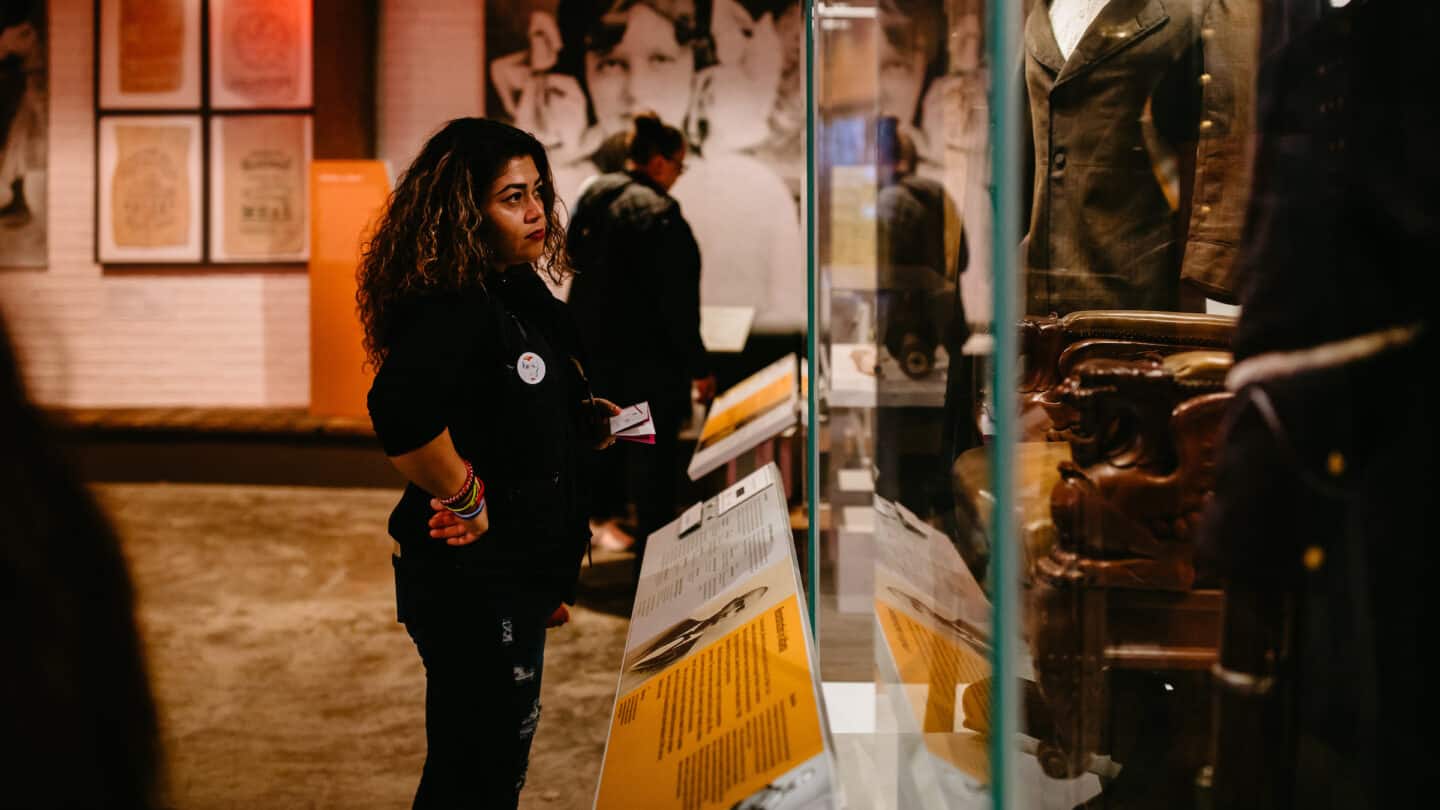Everyone has a story to tell. History belongs to everyone.

These are the guiding principles behind Gatheround: Stories of Atlanta, the Atlanta History Center’s cornerstone exhibition. The 7,700-square-foot permanent exhibition explores the city’s history through stories of individuals who created the Atlanta we know today. They are Atlantans of different backgrounds and perspectives, from unsung citizens who contributed to the city’s progress in modest ways to high-profile leaders who played vital roles in landmark events.
This interactive exhibition is rooted in the past, but is of-the-moment with contemporary relevance. The information shared and questions raised encourage visitors to consider the metro area’s path to the future through a variety of historical milestones and cultural flashpoints.
Gatheround features both newly discovered and rarely discussed stories that display the breadth of our experiences as Atlantans. Atlanta history buffs as well as visitors unfamiliar with our city can all learn something new.
The exhibition is arranged by broad themes relevant to every city dweller’s life: Family & Community, Politics & Justice, Urban Growth, and Cultural Life. The exhibition is multi-disciplinary—rich in artifacts, documents, and multimedia. In addition to expected objects and papers, visitors find music, oral histories, hands-on activities, and computer-based information presentations. There is something for every age, learning style, and level of knowledge.
A Gatheround highlight is set-like interactive spaces, including re-creations of a barbershop and a diner, that host Meet the Past museum theatre performances that help visitors understand and appreciate the people, institutions, and events that shape the stories of Atlanta. Addae Moon, the Atlanta History Center’s Director of Museum Theatre, and other playwrights wrote narratives for actors portraying notable Atlantans. These historic figures include Rosalyn Walton of the Atlanta Nine, the students who desegregated Atlanta Public Schools; John M. Slaton, the Georgia governor who commuted Leo Frank’s death sentence; a newsboy who recounts the 1906 Atlanta Race Riot; and Eli Sotto, a Greek Holocaust survivor who ran a barbershop for six decades in Midtown.
Visitors to Gatheround are greeted by a vibrant seven-minute introductory video, with appearances by notable current and former Atlantans, including Martin Luther King Jr., the Indigo Girls, and Victoria Huynh of the Center for Pan Asian Community Services, all sharing perspectives on what makes Atlanta unique.
Guests are also met with an artifact-focused timeline highlighting events in Atlanta history from a Native American object to time-capsule predictions (written in 1948, and opened a half-century later), of the city’s future. Visitors also are encouraged to explore maps that show the city’s changing geography and infographics that answer questions about population growth, community concerns, and more.
“We do talk about transformational political leaders, but in talking about them we also have to think about the people who voted them in,” said Calinda Lee, Gatheround: Stories of Atlanta curator and Atlanta History Center Vice President of Historical Interpretation and Community Partnerships. “That consideration is crucial in completing the conventional ‘great man’ history. You can’t learn the meaning of wars just by looking at the biographies of the generals. All Atlanta should be able to find themselves in this exhibition.”
Some of the stories the exhibition explores are unblinkingly challenging, representing what organizers term “flashpoints” in the city’s history. They include the Atlanta Race Riot, the trial and 1915 lynching of Leo Frank by an anti-Semitic mob; and the bombing of the Temple synagogue in 1958.
“There are hard stories in our past, and we need to recognize those, and we must talk openly about those,” said Michael Rose, Atlanta History Center’s Executive Vice President. “Some are hard stories that the city still struggles to overcome. We cannot understand one another unless we understand one another’s past and how we remember history differently.”
The exhibition also spotlights lesser-known but important chapters in Atlanta’s story. These include the Washerwomen’s Strike of 1881, when more than 3,000 African American laundresses staged a work stoppage in a united fight for higher wages, a key early development in the American labor movement.
Additionally, the exhibition provides special focus on a varied trio of Atlanta communities: Plaza Fiesta, Inman Park, and Oakland City-Bush Mountain. Believing strongly that neighborhoods are the building blocks of Atlanta, exhibition organizers will explore the stories of other neighborhoods and communities over time in these changing neighborhood sections.
Importantly, as a clear demonstration of the institution’s strong belief in the twin concepts of “Everyone has a story to tell” and that “History belongs to everyone,” the Atlanta History Center urges guests to “gatheround” and share their own Atlanta stories in two recording booths located within the exhibition.
Highlights
Gatheround: Stories of Atlanta boasts nearly 750 artifacts, documents, photographs, and books, including:
- A menu from Leb’s Delicatessen, site of Atlanta Student Movement sit-ins protesting segregation starting in 1960.
- A concrete minaret from Al–Farooq Masjid mosque in Midtown
- A box of .38-caliber bullets purchased during the 1906 Atlanta Race Riots
- The first-baseman’s mitt of Negro Leagues star James “Red” Moore of the Atlanta Black Crackers.
- An 1890 barber’s pole that stood outside one of Alonzo Herndon’s barbershops before he became an insurance mogul and Atlanta’s first African American millionaire
- A costume worn by Jessica Tandy in her role as the title character from the 1989 Atlanta-filmed movie Driving Miss Daisy
Contact
Learn. More.
-
Exhibition
Unsung heroes, go-go boots, and a trolley seat for two! This cornerstone exhibition weaves Atlanta’s stories and artifacts together to define the narrative for our past, present, and future.
-
-
Community Engagement
Through our Neighborhood Initiative, Atlanta History Center is working with local community partners to bring this history to life in new, innovative ways.

